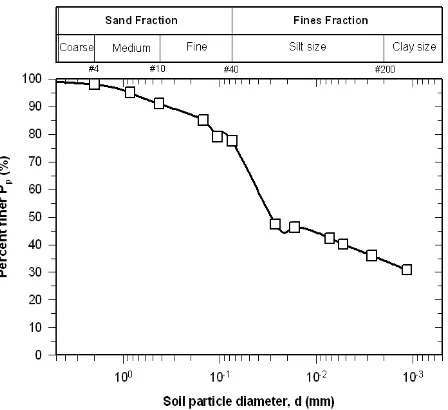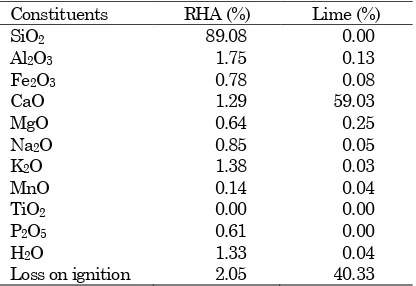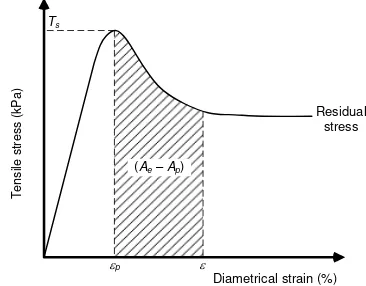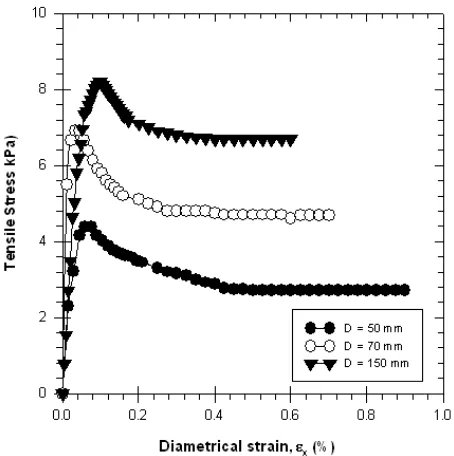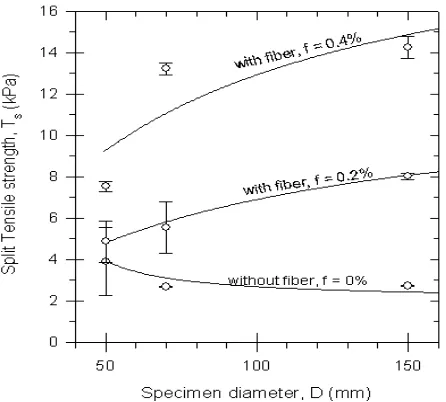Effect of Specimen Size on the Tensile Strength Behavior of the
Plastic Waste Fiber Reinforced Soil
–
Lime
–
Rice Husk Ash
Mixtures
Muntohar, A.S.1
Abstract: Improvement of tensile strength in fiber reinforced soil is an important research topic. A study has been undertaken to investigate the strength of stabilized clay-soil reinforced with randomly distributed discrete plastic waste fibers by carrying out split tensile strength test. In this study, the clay soil was stabilized with lime and rice husk ash mixtures. The main purpose of this research is to investigate the effect of specimen size to the tensile strength behavior. Testing procedure was formulated using extended ASTM C496 standard. The laboratory investigation results showed that split-tensile strength of reinforced specimens increased with increase in size. The limitations of the dataset indicate that specimen size of 70 mm in diameter is the threshold to produce reasonable representative strengths.
Keywords: Specimen size, split-tensile strength, lime-rice husk ash, fiber wastes, soil reinforcement.
Introduction
In recent years, environmental issues have driven interest to utilize industrial by-product as alternative construction material. The well-established industrial by-products, such as fly ash, slag, mine tailing, have been obtained and mixed with lime and cement to improve the geotechnical properties of problematic soils [1]. Over the thirty years, research has been carried out to investigate the utilization of rice husk ash as stabilizing materials in soil improvement technique [2]. Some researches showed that rice husk ash is a promising material to improve lime or cement-stabilized soils [2-4]. Addition of rice husk ash in lime or cement stabilized soils could enhance the compressive strength significantly [5, 6]. However, the higher strength was obtained at smaller strain [7]. This characteristic can be improved by means of inclusion of discrete elements such as fibers in the stabilized soil. Stabilized and reinforced soils are, in general, composite materials that result from combination and optimization of the properties of individual constituent materials. A known approach in this area is the use of fiber-shaped waste materials in the composite [8, 9].
1
Department of Civil Engineering, Universitas Muhammadiyah Yogyakarta, Jl. Lingkar Selatan, Taman Tirto, Yogyakarta, INDONESIA.
Tel. +62-274387656. Fax. +62-274387646. Email: [email protected]
Note: Discussion is expected before November, 1st 2011, and will be
published in the “Civil Engineering Dimension” volume 14, number
1, March 2012.
Received 3 November 2010; revised 13 April 2011; accepted 28 April 2011.
Plastic-waste materials, such as polyethylene tereph-thalate (PET) of plastic bottles, polypropylene (PP) of plastic sack, and polypropylene (PP) of carpet, are produced plentifully. But such materials have rarely been used for engineering purposes, and the over-whelming majority of them have been placed in storage or disposal sites. Utilization of the waste materials for geotechnical materials could convert the waste into a value-added product for soil reinfor-cement. Experimental results reported by various researchers [8-12] showed that the fiber reinforced soil is a potential composite material which can be advantageously employed in improving the structural behavior of the stabilized and unstabilized soils. Investigations of fiber reinforcement system in a cement-stabilized soil have been done successfully by others [13-16]. Mostly these researches studied the compressive strength behavior of the fiber reinforced soil-cement mixtures.
proposed by Bazant et al. [23], about split tensile test on cylinder specimens concluded that the strength would decrease as the size increase. For small diameter, the split-cylinder strength decreased as the diameter increased, but after a certain diameter is exceeded, the trend seems to reverse.
Very little research performed using the appropriate specimen size, to reliably measure behavior of stabilized and reinforced soil with fibers. Preliminary investigation of size effect on the unconfined compression of stabilized and reinforced soil has been done [23-25]. These researches used diameter from 33 mm to 150 mm, in which the ratio of length,
L and diameter, D is kept constant as two (L/D = 2). The compressive strength increased as the specimen diameter increased, and then slightly decreased after a certain size. While no clear threshold size could be established, it appears that the use of specimens with diameter 70 mm or greater would yield reasonable compressive strength of fiber reinforced soils. Yamamoto and Miyake [24] studied the effect of slenderness, that is ratio of length to diameter, with constant diameter (D = 40 mm). The compressive strength of cement-treated soil decreased slightly with increasing slenderness.
Technical standard is required for cylindrical specimens subjected to compressive strength as well as tensile strength of stabilized and reinforced soil. The intent of this paper is to present the preliminary results of tests on split tensile to evaluate the appropriate specimen size of fiber reinforced stabilized soil. It is known that several factors such as stabilizing materials, water content, density, length and content of fibers, soil type, grain size, specimen size, and slenderness, affect the strength, however, in this preliminary study, only fiber content and diameter are considered.
Experimental Program
A series of laboratory testing program was undertaken to evaluate the influence of specimen size and amount of fiber content in the stabilized soil with lime and rice husk ash (RHA) mixtures. The main test done was split tensile tests which was extended from the ASTM C496 [27] procedures. The specimens were mixed with lime and RHA to yield a stabilized soil specimens. Proportion of the lime added into the mixture was based on ASTM D4609 [28], considering plasticity index and lime content relationship. The required lime for stabilization was estimated to be 12% of the dry soil mass. The ratio of the lime to RHA is one to one of the weight of dry soil. Various amounts of plastic waste fibers were
fiber length was 20 mm. Cylindrical specimens were three different sizes as: 50 mm diameter by 100 mm height, 70 mm diameter by 140 mm height, and 150 mm diameter by 300 mm height.
Materials
Soils
The soil used in the present experiment was obtained from the quarry of double-track railway project in Sentolo, Yogyakarta, Indonesia. Based on the preliminary tests of the samples, the specific gravity of the solid was 2.53 in average. The soil samples comprised of 35% clay size fraction, 43% silt size fraction, and 23% sand fraction as shown in the particle size distribution in Figure 1. The liquid limit and plasticity index of the soil were 59% and 29% respectively. The soil was classified as high plasticity clay (CH) according to Unified Soil Classification System [29].
Lime and Rice Husk Ash
To investigate the quality of the RHA, X-Ray difraction (XRD) and X-Ray Fluorescence (XRF) tests were performed. Mineralogy of the rice husk ash and lime used in the research are illustrated in Figure 2. Major mineral constituent of the lime is calcium hydroxides (Ca(OH)2) while the RHA contains
Trydimite mineral. The presence of trydimite indicates that the rice husk ash used in the study contains amorphous silica [30, 31].
Chemical composition of the RHA and lime were examined using X-Ray Fluorescence method (Table 1). The RHA comprised of 89.08% SiO2, 1.75% Al2O3,
0.78% Fe2O3, and 1.29% CaO. These oxides element
are important for evaluating the self-cementing characteristics. The self-cementing characteristics are expressed in terms of hydration, which is defined as the ratio of CaO to the summation of SiO2, Al2O3,
and Fe2O3 [1].
Figure 2. X-Ray difraction of the rice husk ash and lime
Table 1. Chemical elements of the additives
Constituents RHA (%) Lime (%)
SiO2 89.08 0.00
Al2O3 1.75 0.13
Fe2O3 0.78 0.08
CaO 1.29 59.03
MgO 0.64 0.25
Na2O 0.85 0.05
K2O 1.38 0.03
MnO 0.14 0.04
TiO2 0.00 0.00
P2O5 0.61 0.00
H2O 1.33 0.04
Loss on ignition 2.05 40.33
Fiber
Plastic fibers used in the present investigation were cut to the designed length from locally available
plastic bag wastes. The plastic-bag consists of woven polypropylene fibers. The width of single fiber was approximately 2 mm to 2.5 mm. Tensile strength of the plastic fiber specimens was 63 kN/m2 and the
strain at rupture was 15% in average. For this research, the plastic bag was cut to the length of 20 mm to yield a discrete fiber.
Sample Preparation and Test Procedure
The maximum dry density (MDD) and optimum water content (OMC) of the soil were obtained from Standard Proctor compaction. To control the density of all specimens, the specimens were prepared to a desired MDD (d = 10.32 kN/m3) and OMC (wc =
35%) by static compaction method. Predetermined amount of lime and rice husk ash were prepared first in dry mixture, while a certain amount of soil was dry mixed in a mixer. Fibers were then gradually dispersed and added into the mix, followed by the addition of water and further mixing. All fibers were mixed thoroughly to achieve a fairly uniform mixture, then the soil mixture was placed into cylindrical-splitting mould. The assembled mould was then placed on hydraulic jack and a force was applied until the upper plug was in contact with the barrel of the mould. The specimen was dismantled from the mould. The mass of specimen was determined immediately after preparation and then kept in a plastic bag for seven days of curing.
The split tensile tests were carried out in accordance with ASTM C496 Standard [27]. The specimens were subjected to test after moist cured for seven days. Before testing, the mass and dimension of specimen were measured. The load bearing strips were made out of plywood 3 mm thick, 10 mm wide and about equal in length to the specimen length. The bearing strips were placed on top and bottom of the specimen in the correct position and were not reused. The tests were performed on a 50 kN universal-testing machine. The force was applied so that the loading rate was approximately one mm/minute. To measure the tensile deformation of the horizontal diameter due to compressive loading in an orthogonal direction, two dial gauges were installed. Schematic of the test setup is illustrated in Figure 3. The split tensile strength was calculated according to ASTM C496, as follows:
2P T
L D
(1)
where T is split tensile strength; P is applied load; L
(a) Front view (b) Side view
Figure 3. Schematic of test setup
Consoli et al. [10] defined area under the stress– strain curve as energy absorption capacity of soil, ED.
The typical stress–strain curve was shown in Figure 4. The post peak behavior of the material can be explained by the toughness index (TI) value [17,19] which indicates the strain energy to complete failure of the material. The TI was calculated from split stress–strain curve using Equation 2.
the diametrical strain corresponding to the peak stress, and the diametrical strain at a particular point.
In the case of no post peak load, TI is zero, representing a brittle material. The total strain of the mixture increases until a maximum stress is reached where the specimen starts to fail. This maximum stress is referred as split tensile strength, Ts.
(Ae–Ap)
Stress–Strain Response and Toughness Index
Stress–strain curves under split tensile loading for soil–lime–RHA mixtures with and without plastic fibers are shown in Figures 5 to 7. These Figures present a typical split tensile stress–strain curve. It was found that the stress–strain behavior of all specimens is approximately linear up to the peak stress of the specimens. The unreinforced specimens demonstrate typical brittle behavior of failure (Figure 5). The stress decreases immediately after the peak as the specimen fails at smaller diametrical strain. The strain at the peak stress was 0.075%, 0.054%, and 0.021% for specimen diameter of 50 mm, 70 mm, and 150 mm respectively. It was found that the diametrical strain at peak stress decreased slightly as the specimen size increased. This result indicates that smaller specimen size has the ability to prevent crack longer than a larger specimen size. For the reinforced specimen with fiber (Figures 6 and 7), the soil mixtures behaves like elasto-plastic material. After reaching the peak stress, as the load increases, the stress decreased to a certain point, and then keeps constantly associated with the increase in strain. Immediately following the peak, there is a drop ranging between 18% to about 38% and 3% to 15% of the peak in the load carrying capacity for the reinforced specimen with 0.2% and 0.4% fiber content respectively, after which the curves flatten. It can be seen from Figures 5 to 7 that the maximum stress to failure, Ts, for the fiber modified lime–RHA mixtures are significantly higher than the un-modified soil mixtures.
The area under the stress–diametrical strain curve till peak stress represents the toughness of the material related to the elastic energy for failure (Figure 4). Similarly, the post-peak stress–strain behavior indicates that the inclusion of the fibers in soil–lime–RHA mixtures increase the toughness index, TI, of the mixtures (Figure 8). In this study, most of the reinforced specimens showed a maximum strain level greater than 0.6%, therefore a 0.6% strain level was selected as a strain at point of interest to calculate the TI. Hence the TI value was calculated by taking into consideration the area under the stress–strain curves up to a diametrical strain of 0.6%. The figure shows that the TI
research, the fiber was prepared in 20 mm long, the length to diameter ratio (r) were 0.4, 0.286, and
0.133 for specimen diameter of 50 mm, 70 mm, and 150 mm respectively. It was found that the 150 mm diameter specimen has larger shear area but the r
value was lower than the other specimen size. Consoli et al. [10] mentioned that the longer fiber was found to be more pronounced in increasing the energy absorption or toughness of the cemented soil.
Figure 5. Tensile stress and diametrical strain relation-ship of the unreinforced specimens
Figure 6. Tensile stress and diametrical strain relation-ship of the reinforced specimen with 0.2% fiber content
Figure 7. Tensile stress and diametrical strain relation-ship of the reinforced specimen with 0.4% fiber content
Figure 8. Toughness index of the reinforced soil mixtures
Tensile Strength Characteristics
Figure 9. Specimen size effect on the split tensile strength
Similar result was also observed by Yamamoto and Miyake [24] and Omine et. al [32] for unconfined compressive strength of cement-treated clay. The unconfined compressive strength of cement-treated clay soil decreased as the specimen L/D length to diameter ratio increased. In addition, Omine et al. [32] investigated the slenderness effect with different diameter size. Larger diameter produced low com-pressive strength as compared to smaller diameter for specimens of the same length. These researches suggested to use standard diameter, 40 mm to 50 mm, for compressive and splitting-tensile strength test. The results may be attributable by the load distribution effect. In this paper, the width of load distribution strip was designed to be constant (b = 10 mm) for all specimen sizes. As the specimen diameter (D) increases, the ratio of load distribution (b/D) decreases, stress was concentrated nearby the load bearing strip (see test arrangement in Figure 3) for a specimen with larger diameter size. As a result, those specimens would undergo crack earlier than those which are of smaller diameter size. This characteristic was also verified theoretically and experimentally by other investigators [33, 34].
Fiber inclusion can change the brittle behavior to a more ductile one, and make it exhibits ductile behavior. It was observed that inclusion of fiber into stabilized soil enhanced the split tensile strength. It indicates high resistance to tensile cracking. Inclusion of fiber in the stabilized soil would impede further development of tension cracks. Figures 5 to 7 show that tensile strength of the reinforced specimens increased depending on the increases in specimen size and dosage of fiber.
The tensile strength of the treated specimen with
explained that the total contact area between fibers and soil particles increases by increasing fiber content, and consequently the friction between them increases, which contributes to the increase in resistance to the forces applied.
Figure 9 also clearly shows that the tensile strength of the reinforced specimen increases by increasing the specimen size. This characteristic is alluding to explain that the fiber inclusion was easier to distribute uniformly on shear plane in larger specimen diameter. That leads to the increase in the density of the soil, affecting the peak strength of the reinforced soils. Based on the results, it is quite clear that threshold specimen diameter should be used for preparation of split tensile test of fiber inclusion in stabilized soils. Data presented in this paper and by other investigators [24, 35] indicate that specimens of approximately 70 mm in diameter show reasonable representative strengths for fiber lengths of less than 50 mm.
Conclusions
The study reported herein evaluated the tensile strength characteristics of the soil–lime–rice husk ash and plastic waste fiber mixtures. One of the important objectives of this study was to study the specimen size effect on the inclusion of plastic waste fibers in the lime-rice husk ash stabilized soil. The results of this experimental investigation in general indicated that the tensile strength of the reinforced soils increases with increasing specimen size. It is important to note the limitations of the dataset as the boundary for conclusions presented in this paper. The specimen size of 70 mm in diameter is the threshold in producing reasonable representative strengths for fiber lengths of less than 20 mm. Increasing the specimen size to be greater than 70 mm does not show significant difference in the tensile strength. Inclusion of 0.2% and 0.4% plastic waste fibers is able to improve the tensile strength behavior of the stabilized soil. A higher fiber content resulted a higher tensile strength and toughness index of the stabilized soil.
Acknowledgement
References
1. Kamon, M., Nontananandh, S., Combining Industrial Wastes with Lime for Soil Stabilisation,
Journal of Geotechnical Engineering, 117(1), 1990, pp. 1-17.
2. Lazaro, R.C., Moh, Z.C., Stabilisation of Deltaic Clays with Lime-Rice Husk Ash Admixtures,
Proceeding of the 2nd Southeast Asian Conference
on Soil Engineering, Singapore, 11-15 June 1970, pp. 215-223.
3. Rahman, M.A., Effect of Cement-Rice Husk Ash Mixtures on Geotechnical Properties of Lateritic Soils, Soils and Foundations, 27(2), 1987, pp. 61-65.
4. Hossain, A.S.M.M., Hoque, A.M., Zaniewski, J.P., Stabilization of Alluvial Soils with Cement and Cement-Rice Husk Ash Blend for Low-Volume Road Construction in Bangladesh, Transportation Research Record, 1291, 1991, pp. 275-284.
5. Ali, F.H., Adnan, A., Choy, C.K., Use of Rice Husk Ash to Enhance Lime Treatment of Soil, Canadian Geotechnical Journal, 29, 1992, pp. 843-852.
6. Balasubramaniam, A.S., Lin, D.G., Acharya, S.S.S., Kamruzzaman, A.H.M., Uddin, K., Bergado, D.T., Behaviour of Soft Bangkok Clay Treated with Additives, Proceeding of the 11th
Asian Regional Conference on Soil Mechanics and Geotechnical Engineering, Seoul, Korea, 16-20 August 1999, pp. 11-14.
7. Muntohar, A.S. Hashim, R., Silica Waste Utilization in Ground Improvement: A Study of Expansive Soil Treated with LRHA, Proceeding of the 4th International Conference on
Environ-mental Geotechnics, Rio de Janeiro, Brazil, 11-15 August 2002, pp. 515-519.
8. Basha, E.A., Hashim, R., Mahmud, H.B., Muntohar, A.S., Stabilization of Residual Soil with Rice Husk Ash and Cement, Construction and Building Materials, 19(6), 2005, pp. 448-453.
9. Consoli, N.C., Casagrande, M.D.T., Coop, M.R., Effect of Fiber Reinforcement on the Isotropic Compression Behavior of a Sand, Journal of Geotechnical and Geoenvironmental Engineering, 131(11), 2005, pp. 1434-1436.
10.Consoli, N.C., Montardo, J.P., Prietto, P.D.M., Pasa, G.S., Engineering Behavior of a Sand Reinforced with Plastic Waste, Journal of Geotechnical and Geoenvironmental Engineering, 128(6), 2002, pp. 462-472.
11.Ghiassian, H., Poorebrahim, G., Gray, D.H., Soil Reinforcement with Recycled Carpet Wastes,
Waste Management Research, 22(2), 2004, pp. 108-114.
12.Kaniraj, S.R. Gayathri, V., Geotechnical Behavior of Fly Ash Mixed with Randomly Oriented Fiber Inclusions, Geotextiles and Geomembranes, 21(3), 2003, pp. 123-149.
13.Messas, T., Azzouz, R., Coulet, C., Taki, M., Improvement of the Bearing of the Soils by Using Plastic-Rubbish Matters, in Geotechnical Hazards, L. Maric and S. Nossan (Eds.), Balkema: Rotterdam, 1998, pp. 573-579.
14.Cavey, J.K., Krizek, R.J., Sobhan, K., Baker, W.H., Waste Fibers in Cement-Stabilized Recycled Aggregate Base Course Material, Transportation Research Record, 1486, 1995, pp. 97-106.
15.Consoli, N.C., Prietto, P.D.M., Ulbrich, L.A., Influence of Fiber and Cement Addition on Behavior of Sandy Soil, Journal of Geotechnical and Geoenvironmental Engineering, 124(12), 1998, pp. 1211-1214.
16.Kaniraj, S.R., and Havanagi, V.G., Behavior of Cement-Stabilized Fiber-Reinforced Fly Ash- Soil Mixtures, Journal of Geotechnical and Geoenvironmental Engineering, 127(7), 2001, pp. 574-584.
17.Tang, C.S., Shi, B., Gao, W., Chen, F.J., Cai, Y., Strength and Mechanical Behavior of Short Polypropylene Fiber Reinforced and Cement Stabilized Clayey Soil, Geotextiles and Geomem-branes, 25(3), 2007, pp. 194-202.
18.Sobhan, K., Mashnad, M., Tensile Strength and Toughness of Soil–Cement–Fly-Ash Composite Reinforced with Recycled High-Density Polye-thylene Strips, Journal of Materials in Civil Engineering, 14(2), 2002, pp. 177-184.
19.Gaspard, K.J., Mohammad, L.N., Wu, Z., Labora-tory Mechanistic Evaluation of Soil-Cement Mixtures with Fibrillated-Polypropylene Fibers,
Proceeding of the 82th Transportation Research
Board Annual Meeting, Washington D.C., 12-16 January 2003 (CD ROM).
20.Khattak, M.J., Al-Rashidi, M., Durability and Mechanistic Characteristics of Fiber Reinforced Soil-Cement Mixtures, International Journal of Pavement Engineering, 7(1), 2006, pp. 53-62.
21.Kumar, A., Walia, B.S., Bajaj, A., Influence of Fly Ash, Lime, and Polyester Fibers on Compaction and Strength Properties of Expansive Soil,
Journal of Materials in Civil Engineering, 19(3), 2007, pp. 242-248.
23.Bazant, Z.P., Kazemi, M.T., Hasegawa, T., Mazars, J., Size Effect in Brazilian Split-Cylinder Tests: Measurement and Fracture Analysis, ACI Materials Journal, 88(3), 1991, pp. 325-332.
24.Yamamoto, T., Miyake, M., Influence of Specimen Size on Unconfined Compressive Strength of Cement Treated Soil, Journal of the Society of Material Science Japan, 31(341), 1982, pp. 183-187.
25.Nataraj, M.S., McManis, K.L., Strength and Deformation Properties of Soils Reinforced with Fibrillated Fibers, Geosynthetics International, 4(1), 1997, pp. 65-79.
26.Ang, E.C., Loehr, J.E., Specimen Size Effect for Fiber-Reinforced Silty Clay in Unconfined Com-pression, Geotechnical Testing Journal, 26(2), 2003, pp. 191-200.
27.ASTM C496 - 96, Standard Test Method for Splitting Tensile Strength of Cylindrical Concrete Specimens, ASTM International, West Consho-hocken, PA, 2005.
28.ASTM D4609 - 94, Standard Guide for Eva-luating Effectiveness of Chemicals for Soil Stabilization, ASTM International, West Consho-hocken, PA, 2005.
29.ASTM D2487 - 04, Standard Classification of Soils for Practical and Engineering Purposes, ASTM International, West Conshohocken, PA, 2005.
30.Cook, D.J., Rice Husk Ash, in Concrete Tech-nology and Design Cement Replacement Materials, R.N. Swamy (Ed.), Surrey University Press: London, 1986, pp. 171-196.
31.Payá, J., Monzó, J., Borrachero, M.V., Mellado, A., Ordoñez, L.M., Determination of Amorphous Silica in Rice Husk Ash by Rapid Analytical Method, Cement and Concrete Research, 31(2), 2001, pp. 212-231.
32.Omine, K., Ochiai, H., Yasufuku, N., Nayashi, N., Evaluation of the Size Effect on the Strength of Cement-Treated Soils, Proceedings of the 2nd
International Symposium on Hard Soils – Soft Rocks, Naples, Italy, 12-14 October 1998, pp. 751-760.
33.Rocco, C., Guinea, G.V., Planas, J., Elices, M., Size Effect and Boundary Conditions in the Brazilian Test: Experimental Verification, Mate-rials and Structures, 32(3), 1999, pp. 210-217.
34.Namikawa, T., Koseki, J., Evaluation of Tensile Strength of Cement-Treated Sand Based on Several Types of Laboratory Tests, Soils and Foundations, 47(4), 2007, pp. 657-674.
35.Alwahab, R.M., Al-Qurna, H.H., Fiber Reinforced Cohesive Soils for Application in Compacted Earth Structures, Proceedings of Geosynthetics
